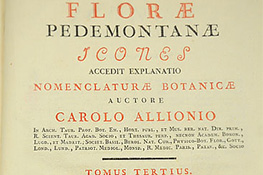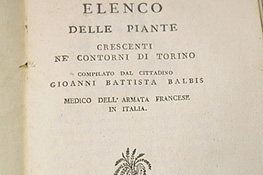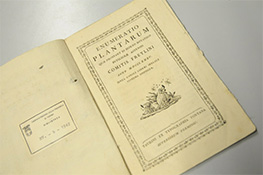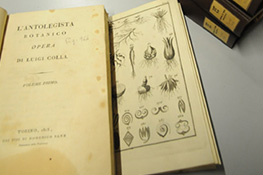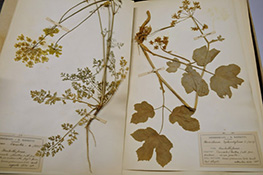Versione italiana English version Version française Versión en español
In the "Giuseppe Grosso" Historical Library are preserved many botanical volumes and curiosities about this topic. Some are from Giulio Fund, whose owner was a well known scientist with a wide variety of interests. Between all this material there are for example the La Théorie e la pratique du jardinage, manual of gardening by the abbot Roger Shabol, printed in Paris in 1767, and the botany treaty Pinax Theatri Botanici by Gaspard Bauhin, Basilea 1671. Bauhin introduced the taxonomy of the binomial nomenclature, later adopted by Linneo. In the Library's collections there are also some scripts written by famous botanists from Piedmont, from Carlo Allioni to Giovanni Battista Balbis, from Lorenzo Freylino to Luigi Colla, of whom there is a specific Fund. The Library also owns a herbarium with specific examples of the territory.
Carlo Allioni
Doctor and botanist from Turin (1728-1804), at the beginning the protomedical of Amedeo III di Savoia and University professor of botany, in 1763 he got the charge of director of the Botanical Garden of Turin. Under his guide the scientific research developed, with the reorganization of the vegetal species and their widening: from 317 they grew to 4.500.
Great scientist, supporter of Linneo's theories with whom he had a great correspondence, he gathered a herbarium composed by 11.000 specimens which, after his death, was purchased by Giovanni Battista Balbi: it is now preserved in the Botanical Garden of Turin.
His main work is the Flora Pedemontana, five enumerate methodica stirpium indigenarum Pedemontii, published in 1785, of which the Libray owns an original copy. This wide treaty made of two volumes, one of the most important botanical traits in the whole Europe and for sure the most important in Piedmont, includes the description of 2831 species of plants in the Piedmont territory, 221 of which are illustrated in 92 splendid iconographic boards by Pietro Peyroleri. The ‘700 is intact the golden century for the botanical illustration, where science and art had a strong communication.
Giovanni Battista Balbis
Politician, doctor and botanist from Piedmont (Moretta 1765 - Turin 1831), he graduated in Turin at medical School, where he could attend the Allioni botany lessons. He was a relevant member of Piedmontese Jacobins, for his liberal and progressive ideas he was involved in the Piedmontese revolutionary movements in 1794 and was exiled in France: his life was since then tangled with the napoleonic adventure, until house Savoy restoration in 1814. This event forced him to retire to the private, but in the end king Vittorio Emanuele I signed his readmission to the Academy of the Sciences of Turin. As a botanist Balbis, during Napoleonic period, directed the Botanical Garden of Turin which, after Allioni's death, fell into disrepair. Thanks to his cures the Garden recovered, and the number of species there grew of 1900 unities. For some years before his death Balbis was also director of Lyon botanical Gardel, well widening it. The herbarium he made is now preserved in the Botanical Garden Of Turin, within the Herbarium Universitatis Taurinensis with Allioni's one.
He studied the Piedmontese flora and discovered the Pinguicola alpina, a typical specimen in Pecetto area.
The Library owns his Catalogus stirpium Horti Academici Taurinensis (Turin 1813), and the Elenco delle piante crescenti ne' contorni di Torino (Turin 1800/1801), with indications of the places where the plants can be found and their properties: Balbis specifies in the introduction that the area about which the book concerns extends for six miles around Turin and adds that this work could be made after many botanical excursions.
The lost garden of Lorenzo Freylino
It's a marvelous botanical garden that was described in 1814 by the scholar Giansecondo De Canis for being the best in Piedmont, with more than six thousand rare plants, trees from many parts of the world and citrus planted in the ground, not in vases. It was situated in Buttigliera d'Asti, inside Baronis palace, become property of count Lorenzo Freylino, keen botanist. In 1785, the same year when Flora Pedemontana by Allioni was released, Freylino published the index of the 953 species he raised, using Linneo's naming and system (the Library owns a copy and a small fund of the botanist's chart).
In his garden he created a setting with neoclassical statues and fish tanks, and also a meteorological station. Jacobin as Balbis and Colla, he donated to his fellow citizens the tree of Freedom, erected the 31 of January 1799 in the centre of the Buttigliera square and decorated with the three colors during a republican feast that lasted three days, when bread, rice, agnolotti and wine were donated.
When Freylino died in 1820, because of many legal disputes, the heritage was dispersed and the garden disappeared since nobody took care of it.
Luigi Colla
Professional jurist, graduated with a thesis inspired by Beccaria's work, Luigi Colla, like Blabis (they were friends) and Freylino, was a political man of Jacobin ideas who took part to the napoleonic epopee, and great botanist from Piedmont (he was born in Turin in 1766 and there died in 1848). As a retired private man he bought a mansion in Rivoli with a large holding that he transformed into a botanical garden. He describes it in his first important work, the Antolegista botanico, released in 1813 in six volumes and 17 engraved boards, printed in 500 copies. Divided into various sections (theoretical naming, vegetal anatomy, living beings morphology, systemography, taxonomy, anthology and description of the raised plants), it concludes with an addendum that provides instructions about how to create gardens. Colla notices the most botanical operas are written in latin instead of Italian, so it results unhandy for botany amateurs and florists for whom his work is thought. Colla also contributed to the description of new exotic species raised in his Rivoli garden, as he did for the banana tree in his monographic work Memoria sul genere Musa, published in 1822, of which the Library owns an edition in folio with three watercolored boards, probably belonging to his daughter Teofila, who collaborated with her father for a long time.
Colla's Herbarium is preserved in Turin at the Botanical Garden.
In the Historical Library are also preserved some charts of the Colla Fund, acquired in 1961, that include 17 folders which contain letters, geographical maps, graduations, notes, printed papers, poems and scientific reports.
A herbarium
The Historical Library also preserves a herbarium, gathered by A. Rapetti between 1930 and 1934, that is composed by 112 papers with as many herbs and flowers, put on a paper with notes that tell place, date, habitat, family, mostly taken in Serra d'Ivrea and in Biella area.

